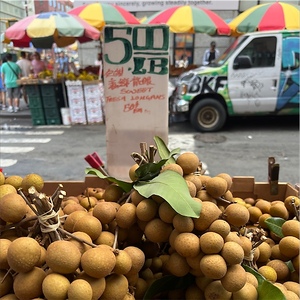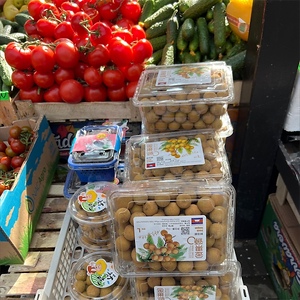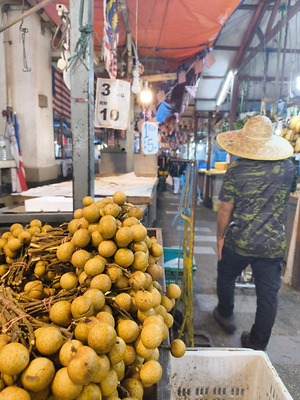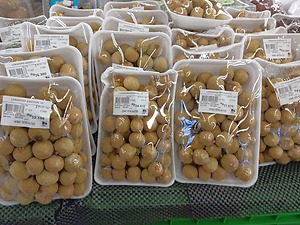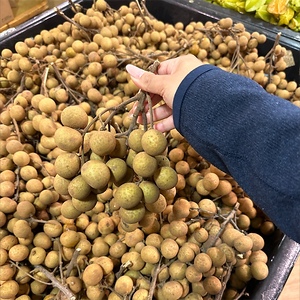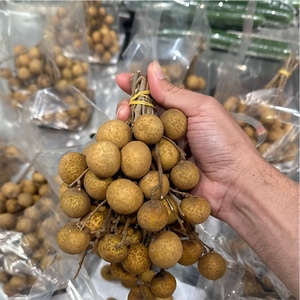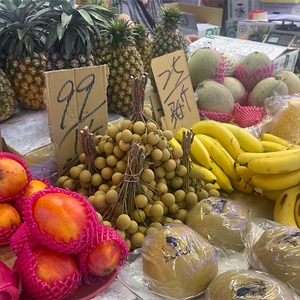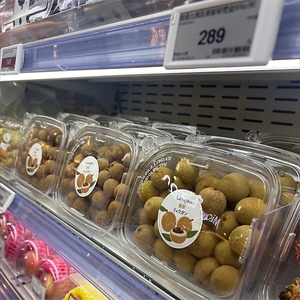


Longan
Estimated Inventory, lb : 0
This item was last sold on : 07/21/24
Description/Taste
Longan fruits are small in size, averaging 1 to 3 centimeters in diameter, and have a round to ovoid shape. The fruits are enveloped in a thin, brittle, and bark-like shell, covered in small bumps, giving the surface a pebbled, rough, and textured feel. The peel also ranges in variegated light brown, green, and yellow hues and is easily removed, revealing a translucent, white-grey flesh. The flesh is semi-firm, succulent, and aqueous, encasing a large, black, and shiny hard seed. The seed is inedible, and the flesh does not cling to the seed. Longan fruits have a faint aroma and emit a sweet, subtly tart, floral, and musky flavor, sometimes releasing gardenia and spruce nuances, depending on the variety.
Seasons/Availability
Longan fruits are available in the late summer through winter.
Current Facts
Longans, botanically classified as Dimocarpus longan, are a tropical Asian fruit belonging to the Sapindaceae family. The small fruits grow in drooping clusters on tropical evergreen trees that can range 9 to 12 meters in height and are favored for their mild, sweet, and succulent nature. Longans are ancient fruits that have been utilized for medicinal and culinary uses for thousands of years across Southeast Asia. One of the unique characteristics of Longan fruit trees is their lifespan, capable of living for over 400 years. The fruits are consumed fresh, cooked, dried, and canned, and there are 30 to 40 commercial varieties of Longan produced in tropical to subtropical climates worldwide. Longans are also known as Longyan, Lungan, Dragon’s Eye, Dragon’s Eyeball, Lam Yai, Leng Keng, and Logana, and some of the common cultivar names include Fukien, Wu Yuan, Tsao Ho, Diamond River, and Kohala.
Nutritional Value
Longan is an excellent source of potassium to balance fluid levels within the body and a good source of vitamin C to strengthen the immune system while reducing inflammation. The fruits also provide phosphorus and calcium to protect bones and teeth, magnesium to control nerve functioning, and other nutrients such as copper, iron, riboflavin, manganese, zinc, and niacin.
Applications
Longan fruits have a mildly sweet and floral flavor well suited for fresh, dried, and canned preparations. The fruit’s thin skin can be peeled, and the flesh can be consumed straight, out of hand, discarding the large center seed. Caution should be taken when biting into the fruit as the seed can be very hard, capable of cracking or chipping teeth. Many consumers choose to lightly bite and suck the flesh from the seed to avoid accidentally biting it. Longan fruits can also be blended into smoothies, pitted and sliced into green and fruit salads, or cut and stirred into ceviche. In addition to fresh preparations, Longan fruits can be simmered into savory soups such as tong sui or congee, cooked with roasted meat dishes, or combined into other sweet and sour main dishes. Longan fruits also complement desserts and can be incorporated into cookies, cheesecake, ice cream, and pudding or poached in a simple sugar syrup. Beyond culinary dishes, Longan fruits are sometimes made into a tea or mixed into cocktails. Longan fruits pair well with mint, meats such as poultry, beef, and pork, seafood, other fruits including lemons, banana, coconut, cherries, and melon, mushrooms, and dates. Whole, unpeeled Longan fruits will keep 5 to 7 days when stored in a plastic bag in the refrigerator. The fruits can also be peeled and frozen or dried for extended use.
Ethnic/Cultural Info
The name Longan is derived from the Cantonese word for “dragon eye.” This mythical moniker was given to the fruit in honor of its similarity in appearance to an eyeball, the black seed being the pupil while the flesh resembles the white of the eye. Dragons are prevalent in Chinese culture and mythology, and over time, Longans became interwoven into the storylines of several folktales involving dragons. One legend from China retells the tale of a dragon terrorizing a coastal town of southern China. The dragon would come into the village with the ocean’s tide each August and would cause the villagers to flee and hide in caves in fear while the dragon ransacked the town. One day a man named Longan saw the dragon’s destruction and vowed to kill the dragon the following year. When August came, Longan prepared a meal of wine-soaked pork and mutton for the dragon, causing the dragon to become drunk once he ate the meat. Longan leaped onto the dragon and stabbed his left eye, but when he popped the eye out of the socket, a fruit came out instead. Another fruit popped out of the dragon’s right eye and fell to the ground. Longan and the dragon fought to the death, with Longan victorious, but he eventually perished due to unhealable wounds. The villagers were relieved the dragon was gone and carefully buried Longan’s body with the fruits that sprang from the dragon’s eyes. The following year, two fruit trees bearing clusters of small eye-like fruits grew from the burial site. The villagers named the fruits Longan in honor of the fallen hero.
Geography/History
Longan fruits are native to China and regions of Southeast Asia, where the fruit trees have been growing wild for thousands of years. The ancient fruits were first found in the regions of Guangxi, Fujian, Sichuan, and Guandong, China, and were also reported to have been found in lowland and mountainous areas spanning from India to China. Experts believe the earliest record of Longan can be traced back to 200 BCE. The record indicated that the emperor had requested Longan and lychee trees to be planted in the Shaanxi Palace gardens during the Han dynasty. Longan fruits were extensively grown and produced throughout China, later spreading along trade routes and merchant ships into Europe in the late 1700s and Australia in the mid-1800s. The United States Department of Agriculture imported Longan fruits in 1903, and the tropical to subtropical fruits flourished in Florida and Hawaii. Today Longan fruits are widely cultivated and found through local markets in Asia and Southeast Asia. While less common than lychees, the fruits are also being grown on a small scale through growers in Australia, Mauritius, the Philippines, and in the United States in California, Hawaii, and southern Florida. Canned Longan fruits are exported from Hong Kong and Taiwan and sold in markets worldwide. When in season, Longan fruits can be found through specialty markets, local vendors, and distributors and are sometimes grown in home gardens.
Recipe Ideas
Recipes that include Longan. One



